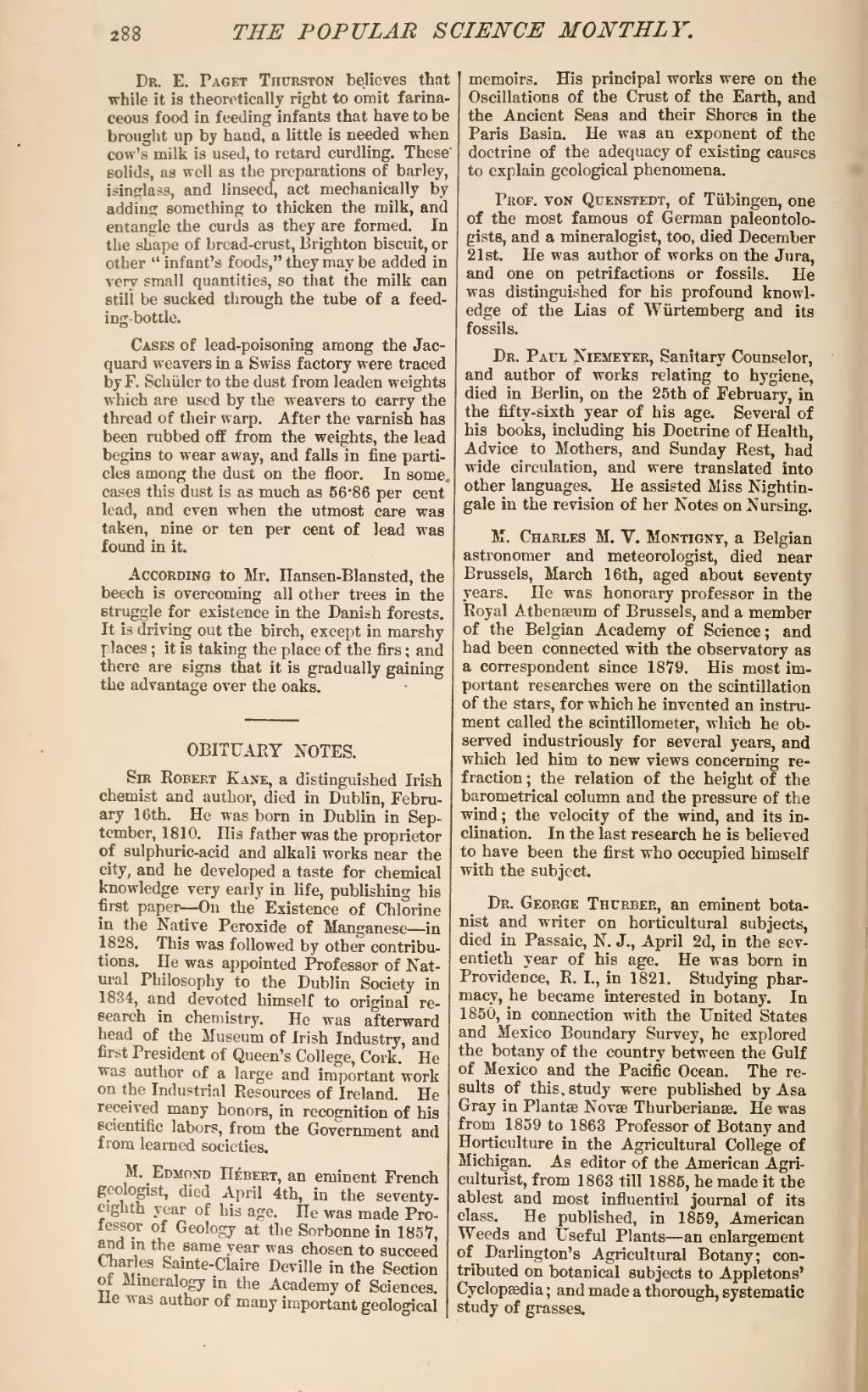Dr. E. Paget Thurston believes that while it is theoretically right to omit farinaceous food in feeding infants that have to be brought up by hand, a little is needed when cow's milk is used, to retard curdling. These solids, as well as the preparations of barley, Isinglass, and linseed, act mechanically by adding something to thicken the milk, and entangle the curds as they are formed. In the shape of bread-crust, Brighton biscuit, or other "infant's foods," they may be added in very small quantities, so that the milk can still be sucked through the tube of a feeding-bottle.
Cases of lead-poisoning among the Jacquard weavers in a Swiss factory were traced by F. Schüler to the dust from leaden weights which are used by the weavers to carry the thread of their warp. After the varnish has been rubbed off from the weights, the lead begins to wear away, and falls in fine particles among the dust on the floor. In some, cases this dust is as much as 56*86 per cent lead, and even when the utmost care was taken, nine or ten per cent of lead was found in it.
According to Mr. Hansen-Blansted, the beech is overcoming all other trees in the struggle for existence in the Danish forests. It is driving out the birch, except in marshy places; it is taking the place of the firs; and there are signs that it is gradually gaining the advantage over the oaks.
Sir Robert Kane, a distinguished Irish chemist and author, died in Dublin, February 16th. He was born in Dublin in September, 1810. His father was the proprietor of sulphuric-acid and alkali works near the city, and he developed a taste for chemical knowledge very early in life, publishing his first paper—On the Existence of Chlorine in the Native Peroxide of Manganese—in 1828. This was followed by other contributions. He was appointed Professor of Natural Philosophy to the Dublin Society in 1834, and devoted himself to original research in chemistry. He was afterward head of the Museum of Irish Industry, and first President of Queen's College, Cork. He was author of a large and important work on the Industrial Resources of Ireland. He received many honors, in recognition of his scientific labors, from the Government and from learned societies.
M. Edmond Hébert, an eminent French geologist, died April 4th, in the seventy-eighth year of his age. He was made Professor of Geology at the Sorbonne in 1857, and in the same year was chosen to succeed Charles Sainte-Claire Deville in the Section of Mineralogy in the Academy of Sciences. He was author of many important geological memoirs. His principal works were on the Oscillations of the Crust of the Earth, and the Ancient Seas and their Shores in the Paris Basin. He was an exponent of the doctrine of the adequacy of existing causes to explain geological phenomena.
Prof, von Quenstedt, of Tübingen, one of the most famous of German paleontologists, and a mineralogist, too, died December 21st. He was author of works on the Jura, and one on petrifactions or fossils. He was distinguished for his profound knowledge of the Lias of Würtemberg and its fossils.
Dr. Paul Niemeyer, Sanitary Counselor, and author of works relating to hygiene, died in Berlin, on the 25th of February, in the fifty-sixth year of his age. Several of his books, including his Doctrine of Health, Advice to Mothers, and Sunday Rest, had wide circulation, and were translated into other languages. He assisted Miss Nightingale in the revision of her Notes on Nursing.
M. Charles M. V. Montigny, a Belgian astronomer and meteorologist, died near Brussels, March 16th, aged about seventy years. He was honorary professor in the Royal Athenæum of Brussels, and a member of the Belgian Academy of Science; and had been connected with the observatory as a correspondent since 1879. His most important researches were on the scintillation of the stars, for which he invented an instrument called the scintillometer, which he observed industriously for several years, and which led him to new views concerning refraction; the relation of the height of the barometrical column and the pressure of the wind; the velocity of the wind, and its inclination. In the last research he is believed to have been the first who occupied himself with the subject.
Dr. George Thurber, an eminent botanist and writer on horticultural subjects, died in Passaic, N. J., April 2d, in the seventieth year of his age. He was born in Providence, R. I., in 1821. Studying pharmacy, he became interested in botany. In 1850, in connection with the United States and Mexico Boundary Survey, he explored the botany of the country between the Gulf of Mexico and the Pacific Ocean. The results of this, study were published by Asa Gray in Plantæ Novæ Thurberianæ. He was from 1859 to 1863 Professor of Botany and Horticulture in the Agricultural College of Michigan. As editor of the American Agriculturist, from 1863 till 1885, he made it the ablest and most influential journal of its class. He published, in 1859, American Weeds and Useful Plants—an enlargement of Darlington's Agricultural Botany; contributed on botanical subjects to Appletons' Cyclopædia; and made a thorough, systematic study of grasses.

